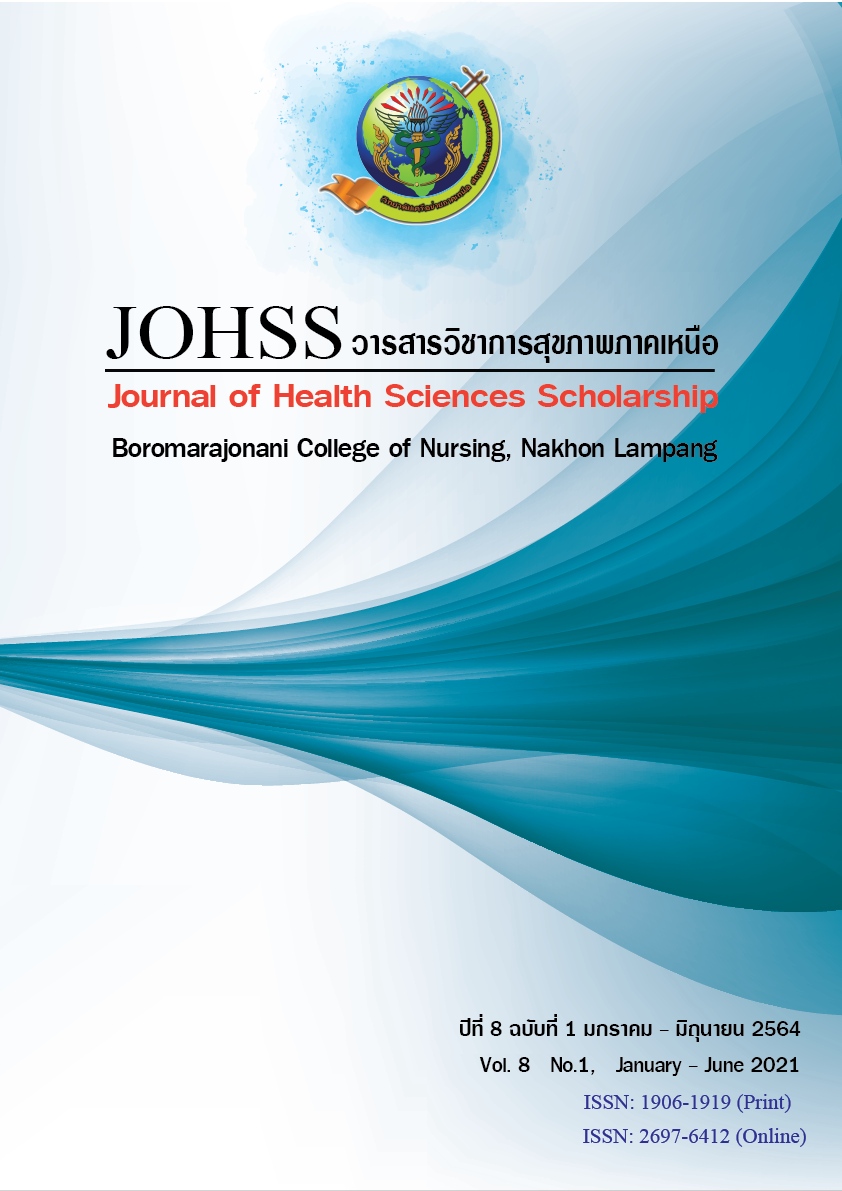การวิเคราะห์องค์ประกอบของคุณลักษณะพื้นฐานสำหรับการประกอบการธุรกิจ ของนักศึกษาพยาบาล วิทยาลัยพยาบาลบรมราชชนนี นครลำปาง
คำสำคัญ:
การวิเคราะห์องค์ประกอบเชิงสำรวจ, คุณลักษณะ, การประกอบการธุรกิจ, นักศึกษาพยาบาลบทคัดย่อ
การวิจัยนี้เป็นการวิจัยเชิงพรรณนา มีวัตถุประสงค์เพื่อศึกษาองค์ประกอบของคุณลักษณะพื้นฐานสำหรับการประกอบการธุรกิจในนักศึกษาพยาบาล โดยเก็บข้อมูลจากกลุ่มประชากรซึ่งเป็นนักศึกษาพยาบาล วิทยาลัยพยาบาลบรมราชชนนี นครลำปาง จำนวน 567 คน วิเคราะห์ข้อมูลโดยใช้การวิเคราะห์องค์ประกอบเชิงสำรวจ (Exploratory Factor Analysis: EFA) ด้วยการวิธีสกัดองค์ประกอบหลัก (principal component analysis) และหมุนแกนองค์ประกอบตั้งฉากด้วยวิธีแวริแมกซ์ (varimax)
ผลการวิจัย พบว่าชุดตัวแปรที่ทำการศึกษาสามารถวิเคราะห์องค์ประกอบได้ 6 องค์ประกอบ ได้แก่ การบริหารจัดการเชิงกลยุทธ์, การมีทักษะร่วมสมัย, การมีจุดยืนมุ่งความสำเร็จ, การสร้างสรรค์คุณค่าที่โดดเด่น และความสามารถในการเผชิญกับความไม่แน่นอน ซึ่งสามารถอธิบายความแปรปรวนสะสมได้ร้อยละ 42.9
คุณลักษณะพื้นฐานสำหรับการประกอบการธุรกิจของนักศึกษาพยาบาลทั้ง 6 องค์ประกอบนี้ผู้ที่เกี่ยวข้องสามารถนำไปใช้การจัดการเรียนการสอนรายวิชาการประกอบการธุรกิจและการพัฒนาคุณลักษณะด้านนี้สำหรับนักศึกษาพยาบาลต่อไป
เอกสารอ้างอิง
Andrade, A. D. C., Ben, L. W. D., & Sanna, M. C. (2015). Entrepreneurship in nursing: overview of companies in the
State of São Paulo. Revista brasileira de enfermagem, 68(1), 40-44.
Aqeel, A. M. B., Awan, A. N., & Riaz, A. (2011). Determinants of business success (an exploratory study).
International journal of human resource studies,1(1), 98-110.
Dionisio, M. A. (2017). Strategic thinking: The role in successful management. Journal of management
research,9(4), 44-57.
Division of Research Management and Educational Quality Assurance. (2016). Thailand 4.0 Model for driving
Thailand towards prosperity, stability and sustainability. (online), Available: http://www.libarts.up.ac.th/v2/img/Thailand-4.0.pdf. (in thai)
Guo, K. L. (2003). Applying entrepreneurship to health care organizations. New england journal of
entrepreneurship, 6(1), 45-53.
Guo K. L. (2009). Core competencies of the entrepreneurial leader in health care organization. The health care
manager, 28(1), 19-29.
Hakanen, M., & Häkkinen, M. (2015). Management possibilities for interpersonal trust in a business network.
Case: health, exercise-and wellbeing markets. Nordic journal of business, 64(4), 249-265.
Hair, J. F., Anderson, R. E., Babin, B. J., & Black, W. C. (2010). Multivariate data analysis: A global perspective (Vol.
: Pearson upper saddle river.
Linnenluecke, M. K. (2017). Resilience in business and management research: A review of influential publications
and a research agenda. International journal of management reviews, 19(1), 4-30.
Mäkilä, M. (2014). Resilience as a way to improve business continuity: a multiple case study with large Nordic
companies. (Master's thesis) Department of information and service economy aalto university school of business.
Malekipour, A., Hakimzadeh, R., Dehghani, M., & Zali, M. R. (2018). Analysis of entrepreneurial competency
training in the curriculum of bachelor of physical education in universities in Iran. Cogent education, 5(1), 1-15.
Mojab, F., Zaefarian, R., Azizi., & AHD. (2011). Applying competency based approach for entrepreneurship
education. Procedia soc behav sci, 12(1), 436–447.
Nguyen, V. N., Forbes, H., Mohebbi, M., & Duke, M. (2017). Development and validation of an instrument to
measure nurse educator perceived confidence in clinical teaching. Nursing & health sciences, 19(4), 498-508.
Nnadi, C. (2014). The role of creativity and innovation in business growth and sustainability: An ideal model.
International journal of economics & management sciences, 3(1), 1-9.
Office of policy and strategy, Office of the permanent secretary & ministry of public health ministry of public health. (2016). Healthy citizens, happy staff, sustainable health systems. Position, vision, mission, goals
and strategies of the Ministry of Public Health. (online), Available: http://bps.moph .go.th/new_bps/
sites/default/ files/Positioning_MoPH_2559.pdf. (in thai)
Polit, D. F., & Beck, C. T. (2008). Nursing research: Generating and assessing evidence for nursing practice (8th
ed.). Philadelphia: Wolters kluwer health/Lippincott Williams & wilkins.
Rubino, L., & Freshman, B. (2005). Developing entrepreneurial competencies in the health care management
undergraduate classroom. J health adm educ, 22(4), 399-416.
Salminen, L., Lindberg, E., Gustafsson, M. L., Heinonen, J., & Leino-Kilpi, H. (2014). Entrepreneurship education in
health care education. Education research international, 2014(1), 1-8.
Santiprapob, V. (2018). Adaptation to accommodate changes in the 4.0 era is not an option, but it is inevitable.
(online), Available: https://thaipublica.org/2018/09/veerathai-the-future-of-central-banking/. (2018, 1
December 1). (in thai)
Somera, K., & Holt, M. K. (2015). Integrity in business: An evaluation of integrity across German and American
culture. International Journal of Business and Social Science, 6(2), 32-36.
Ventureprise. (2013). Enterpreneurial competency: characteristics of success. Ventureprise, Inc.
Reyes, G., Mariano, R. A., Herrera, M. N. Q., Manipol, N. E. P., & Cabardo, J. J. S. (2018). Personal entrepreneurial
competencies and entrepreneurial intention of non-business students enrolled in an introductory
entrepreneurship course. Journal of economics, management & agricultural developmen, 4(1), 93-102.
Yusoff, W. F. W., & Lame, S. M. (2017). What would the required entrepreneurial competencies for
entrepreneurship lecturers in higher learning institutions? Saudi journal of business and management
studies, 2(8), 787-794.
Zahra, S. A., & Nambisan, S. (2012). Entrepreneurship and strategic thinking in business ecosystems. Business
horizons, 55(3), 219-229.
ดาวน์โหลด
เผยแพร่แล้ว
ฉบับ
ประเภทบทความ
สัญญาอนุญาต
ลิขสิทธิ์ (c) 2021 วารสารวิชาการสุขภาพภาคเหนือ

อนุญาตภายใต้เงื่อนไข Creative Commons Attribution-NonCommercial-NoDerivatives 4.0 International License.
บทความ ข้อมูล เนื้อหา รูปภาพ ฯลฯ ที่ได้รับการตีพิมพ์ในวารสารวารสารวิชาการสุขภาพภาคเหนือ ถือเป็นลิขสิทธิ์ของวารสารวารสารวิชาการสุขภาพภาคเหนือ หากบุคคลหรือหน่วยงานใดต้องการนำทั้งหมดหรือส่วนหนึ่งส่วนใดไปเผยแพร่ต่อหรือเพื่อกระทำการใดๆ จะต้องได้รับอนุญาตเป็นลายลักอักษรจากวารสารวารสารวิชาการสุขภาพภาคเหนือก่อนเท่านั้น
เนื้อหาและข้อมูลในบทความที่ลงตีพิมพ์ในวารสารวิชาการสุขภาพภาคเหนือถือเป็นข้อคิดเห็นและความรับผิดชอบของผู้เขียนบทความโดยตรงซึ่งกองบรรณาธิการวารสาร ไม่จำเป็นต้องเห็นด้วย หรือร่วมรับผิดชอบใดๆ
อนึ่ง ข้อความและข้อคิดเห็นต่างๆ เป็นของผู้เขียนบทความนั้นๆ ไม่ถือเป็นความเห็นของวารสารฯ และวารสารฯ ไม่จำเป็นต้องเห็นด้วยกับข้อความและข้อคิดเห็นใดๆ ของผู้เขียน วารสารฯ ขอสงวนสิทธิ์ในการพิจารณาตีพิมพ์ตามความเหมาะสม รวมทั้งการตรวจทานแก้ไขหรือขัดเกลาภาษาให้ถูกต้องตามเกณฑ์ที่กำหนด



